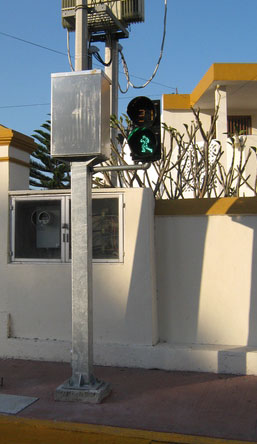Deep-cycle battery
Deep-cycle battery refers to a type of lead-acid battery designed to be regularly deeply discharged using most of its capacity. Unlike starter batteries (such as those used in cars) which are designed to deliver short, high-current bursts for cranking the engine, deep-cycle batteries are designed to provide a steady amount of current over a long period. They are commonly used in renewable energy systems, golf carts, forklifts, boats, and as storage batteries for off-grid power systems.
Design and Function[edit | edit source]
Deep-cycle batteries are designed with thicker lead plates and a high-density active material to withstand deep cycling. These design features allow the battery to be discharged up to 80% of its capacity, although many manufacturers recommend not discharging below 50% to extend the battery's life. The deep discharge capability makes them suitable for applications where the battery needs to provide power for longer periods without immediate recharging.
Types of Deep-Cycle Batteries[edit | edit source]
There are several types of deep-cycle batteries, each with its own specific applications and benefits:
- Flooded Lead Acid: These batteries require regular maintenance, including checking the electrolyte levels and adding distilled water. They are more affordable but require ventilation due to the gases they emit during charging.
- Sealed Lead Acid (SLA) / Valve Regulated Lead Acid (VRLA): These batteries are maintenance-free and can be mounted in any position. They are divided into two main types: Gel Cell and Absorbed Glass Mat (AGM). Gel cell batteries use a gelified electrolyte, while AGM batteries use a fiberglass mat to absorb the electrolyte. Both types are more expensive than flooded lead-acid batteries but offer advantages in terms of maintenance and spill-proof characteristics.
- Lithium-Ion: While not traditionally used for deep-cycle applications, lithium-ion batteries are becoming more popular due to their high energy density, lightweight, and longer lifespan. They are significantly more expensive but offer a higher return on investment over time due to their durability and efficiency.
Applications[edit | edit source]
Deep-cycle batteries are used in a variety of applications, including:
- Renewable Energy Systems: In solar and wind power systems, deep-cycle batteries store energy for use when the sun is not shining or the wind is not blowing.
- Electric Vehicles: Golf carts and electric forklifts use deep-cycle batteries as their primary source of power.
- Marine Applications: Boats and other marine vehicles use deep-cycle batteries to power trolling motors, electronics, and other onboard equipment.
- Recreational Vehicles (RVs): Used to power appliances and electronics when the RV is not connected to a power source.
- Off-grid Power Systems: In remote locations without access to the electrical grid, deep-cycle batteries store power generated by solar panels or wind turbines.
Maintenance and Care[edit | edit source]
Proper maintenance and care are crucial to extending the life of a deep-cycle battery. This includes regular cleaning of terminals, checking electrolyte levels in flooded batteries, ensuring the battery is charged correctly, and avoiding over-discharging. For sealed batteries, it's important to follow the manufacturer's guidelines for charging to prevent damage.
Environmental Considerations[edit | edit source]
Recycling is an important aspect of the life cycle of deep-cycle batteries, especially lead-acid types. The lead, plastic, and electrolyte in these batteries can be recycled to reduce environmental impact. Users are encouraged to dispose of batteries responsibly at the end of their life cycle.
| Deep-cycle battery Resources | |
|---|---|
|
|
Search WikiMD
Ad.Tired of being Overweight? Try W8MD's physician weight loss program.
Semaglutide (Ozempic / Wegovy and Tirzepatide (Mounjaro / Zepbound) available.
Advertise on WikiMD
|
WikiMD's Wellness Encyclopedia |
| Let Food Be Thy Medicine Medicine Thy Food - Hippocrates |
Translate this page: - East Asian
中文,
日本,
한국어,
South Asian
हिन्दी,
தமிழ்,
తెలుగు,
Urdu,
ಕನ್ನಡ,
Southeast Asian
Indonesian,
Vietnamese,
Thai,
မြန်မာဘာသာ,
বাংলা
European
español,
Deutsch,
français,
Greek,
português do Brasil,
polski,
română,
русский,
Nederlands,
norsk,
svenska,
suomi,
Italian
Middle Eastern & African
عربى,
Turkish,
Persian,
Hebrew,
Afrikaans,
isiZulu,
Kiswahili,
Other
Bulgarian,
Hungarian,
Czech,
Swedish,
മലയാളം,
मराठी,
ਪੰਜਾਬੀ,
ગુજરાતી,
Portuguese,
Ukrainian
Medical Disclaimer: WikiMD is not a substitute for professional medical advice. The information on WikiMD is provided as an information resource only, may be incorrect, outdated or misleading, and is not to be used or relied on for any diagnostic or treatment purposes. Please consult your health care provider before making any healthcare decisions or for guidance about a specific medical condition. WikiMD expressly disclaims responsibility, and shall have no liability, for any damages, loss, injury, or liability whatsoever suffered as a result of your reliance on the information contained in this site. By visiting this site you agree to the foregoing terms and conditions, which may from time to time be changed or supplemented by WikiMD. If you do not agree to the foregoing terms and conditions, you should not enter or use this site. See full disclaimer.
Credits:Most images are courtesy of Wikimedia commons, and templates Wikipedia, licensed under CC BY SA or similar.
Contributors: Prab R. Tumpati, MD



